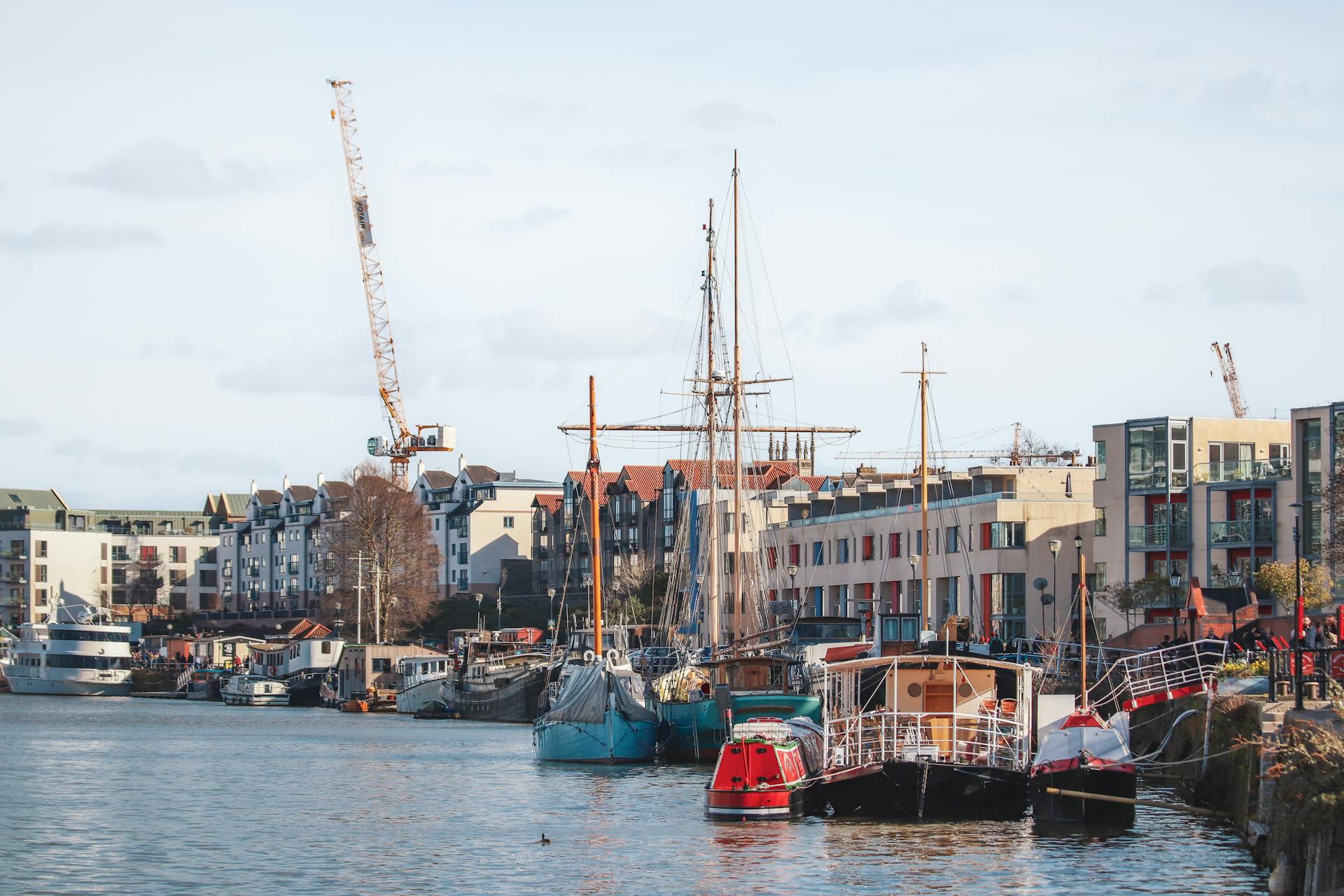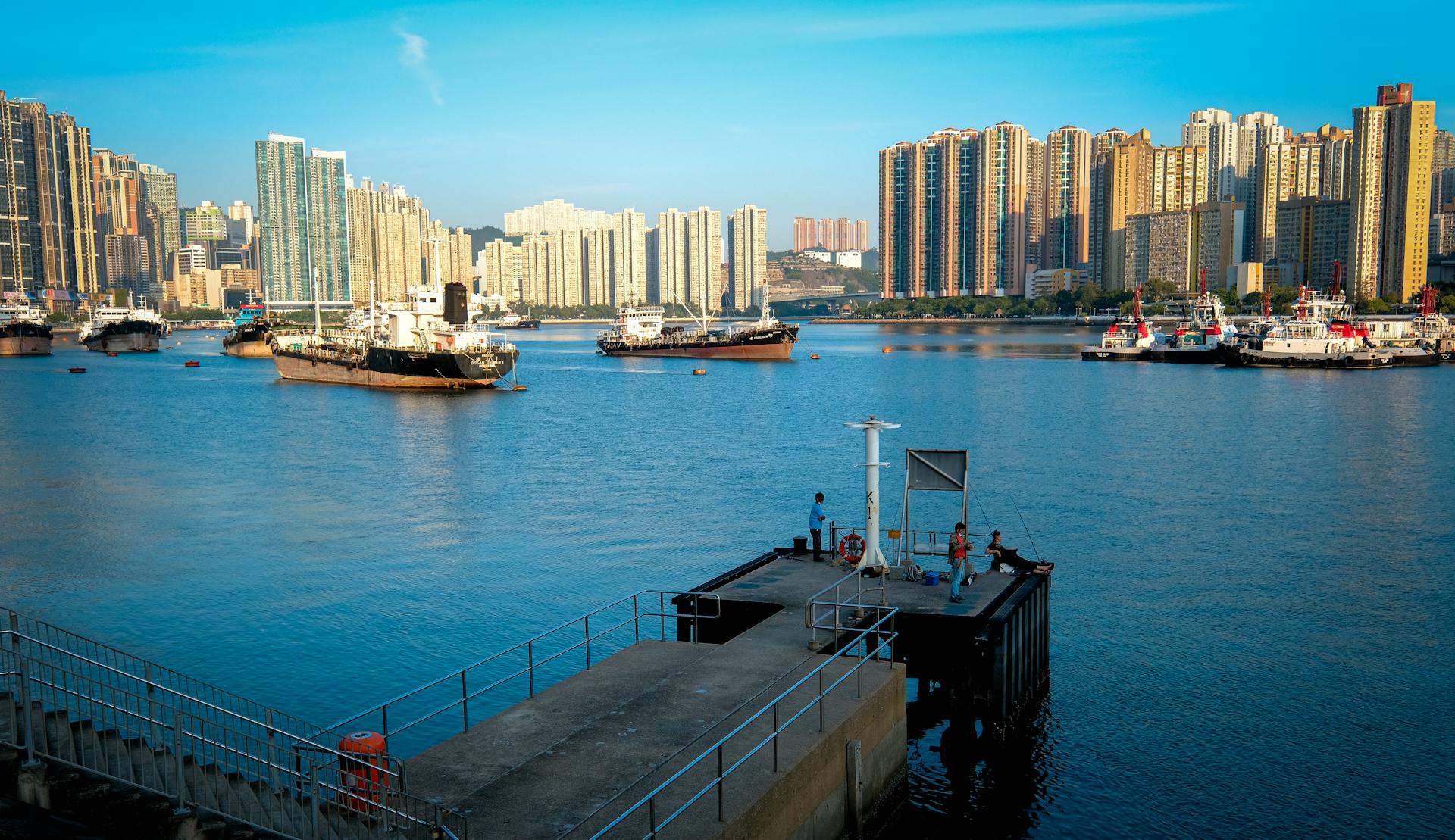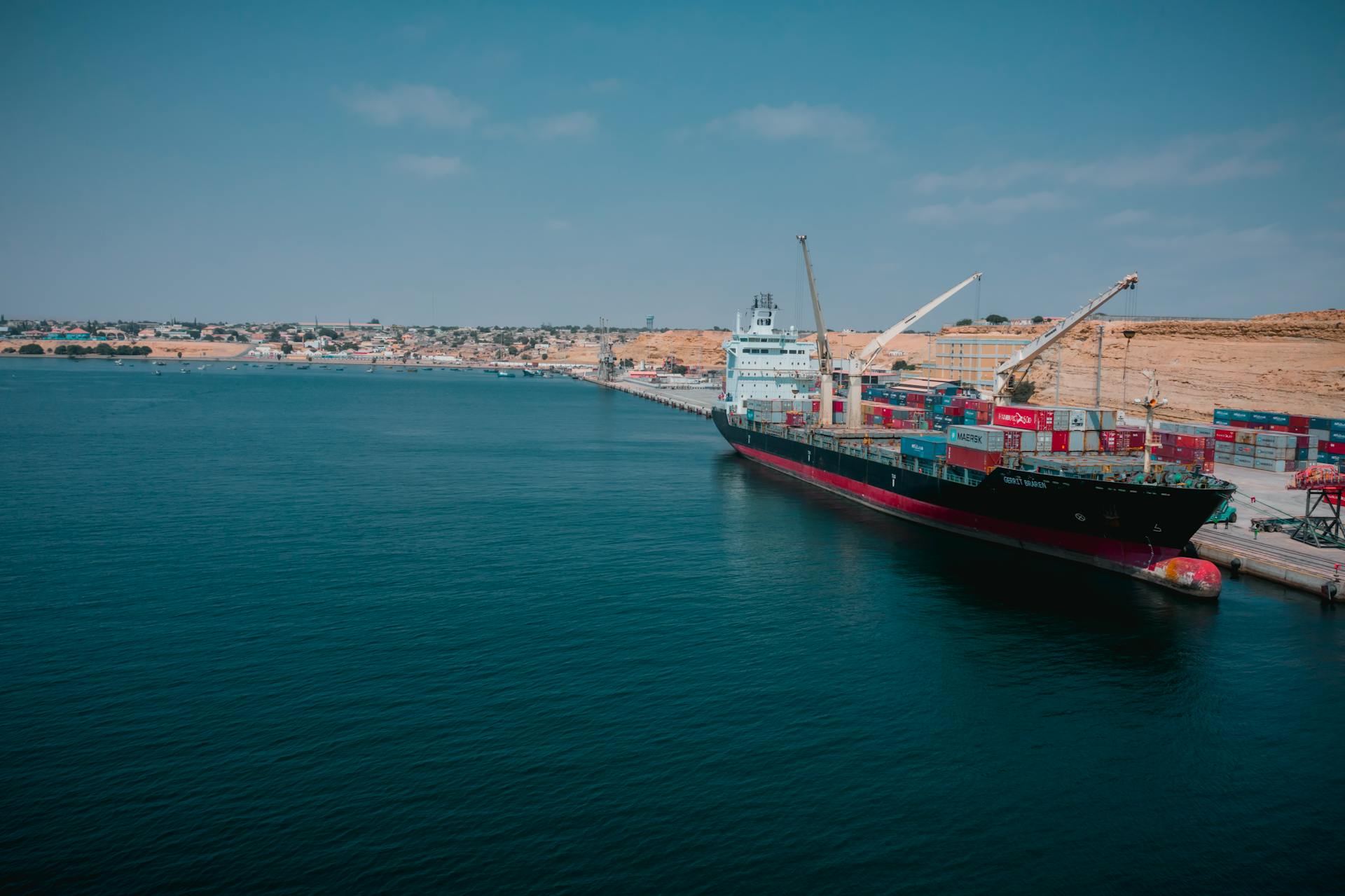
Bristol's ports have a rich history dating back to the 13th century.
The city's strategic location on the River Avon made it an ideal place for trade and commerce.
Bristol's ports have played a significant role in the city's growth and development over the centuries.
The Port of Bristol Authority was established in 1972 to manage and regulate the port.
Facilities
The port in Bristol has a lot to offer when it comes to facilities.
The port features two docks, Royal Portbury and Avonmouth, which consist of over 35 berths.
These docks provide access to the port terminals via the Royal Portbury Lock and Avonmouth Lock.
The main anchorage at Breaksea is dedicated to medium and small vessels.
The anchorage area near Swansea Bay and South Wales is better suited for larger vessels.
There is also a designated anchorage for small pleasure craft at the entrance of the River Avon.
Getting to Bristol Port
Getting to Bristol Port is relatively straightforward, especially if you're driving. From the M5, exit at junction 19 and follow the signs for Royal Portbury Dock.
To get to the cruise terminal, take the 5th exit off the roundabout signposted onto Royal Portbury Dock Road. You can also take a taxi, with options including Yellow Cab Co, AA Taxi, and National Taxis, all with local phone numbers.
If you're coming from Bristol Temple Meads Station, it's about a 20-minute drive, while Bristol Parkway is a bit further, around 25 minutes. Both stations have taxi ranks, making it easy to get to the port.
Bristol Airport is also a viable option, located about 12.5 miles from the port, with a drive time of around 25 minutes, depending on traffic.
Here are the local taxi numbers for your convenience:
- Yellow Cab Co – 01179 231515
- AA Taxi – 01174 449839
- National Taxis – 01179 519900
Bristol Port Information
The Port of Bristol is a major cargo port located on the River Avon in Avonmouth, Bristol. It's one of the largest ports in the UK.
The port handles a wide range of cargo, including containers, vehicles, and bulk commodities like coal and aggregates.
The port's container terminal is operated by DP World and has a capacity to handle over 1 million containers per year.
The port's strategic location on the River Avon allows for easy access to the M5 and M4 motorways, making it an ideal hub for cargo transportation.
The port is also home to a number of other cargo handling facilities, including a vehicle terminal and a bulk cargo terminal.
Port Operations
Port Operations in Bristol are a complex process, involving multiple stakeholders and activities.
The Port of Bristol has a long history, dating back to the 13th century, when it was a major hub for the wool trade.
Cargo handling is a crucial aspect of port operations, with the port handling over 100,000 containers annually.
Freeport
The Port of Bristol was proposed as one of six sites for a Freeport by Boris Johnson, who saw it as an excellent way to boost investment in left-behind areas.
This move was welcomed by the Bristol Port Company, who believed it could bring new investment opportunities to the area around UK ports.
However, some experts predicted that the main effect of a Freeport would be to divert activity from the surrounding region rather than create new jobs.
A new deepsea container terminal was planned in Avonmouth as of 2010, but its status and current developments are unclear.
Commercial and Renewable Energy
The Bristol Port is a major UK port that covers 2,600 acres on the Severn Estuary. It provides a full range of shipping, distribution, and logistics services with direct rail and motorway access to the rest of the UK.
The port's location is adjacent to environmentally sensitive areas, including the Severn Estuary and the Bristol Green Belt. The Bristol Port Company has made significant investments in maintaining and enhancing its environment.
The Landmark Practice has provided ecology and landscape services to the port for 20 years. They've helped the port generate economic development alongside environmental benefits.
Some of the services provided by The Landmark Practice include producing environmental statements, securing planning for wind turbines, and conducting ecological monitoring and survey work. They've also produced mitigation planting plans and monitoring establishing planting.
The port has a Landscape and Wildlife Masterplan that provides a flexible framework for new development within a strategic network of wildlife corridors. This Masterplan is maintained by The Landmark Practice and is updated regularly.
The port has secured planning for 3 wind turbines that provide about 1/3 of its electricity needs. This was achieved through a robust EIA and Habitats Regulations Assessment, and the project won the first RTPI Environmental Planning and Protection Network Award.
Port Equipment
The port in Bristol is equipped with a variety of cranes to handle different types of cargo. A 150t floating crane is available for use.
Wide-span gantry cranes can be found at Avonmouth Container Terminal, capable of lifting cargo between road transport, rail, compound, and vessel. Two of these cranes are situated at the terminal.
A rail-mounted Gottwald HSK 260 EG crane is also present, designed to handle various cargo categories.
Frequently Asked Questions
What was the old Bristol port?
Bristol Harbour was the original Port of Bristol, but it's since been largely replaced by larger docks at Avonmouth and Portbury.
Where do cruises go from in Bristol?
Cruises from Bristol depart from either the Avonmouth Dock or Portbury Cruise Terminal, located approximately six miles from the city centre.
Sources
- https://en.wikipedia.org/wiki/Port_of_Bristol
- https://www.ship-technology.com/projects/portofbristol/
- https://www.ambassadorcruiseline.com/before-you-sail/travelling-to-port/bristol-port-information/
- https://www.multimodal.org.uk/exhibitor-article/the-bristol-port-company
- https://thelandmarkpractice.com/project/the-bristol-port-company/
Featured Images: pexels.com


